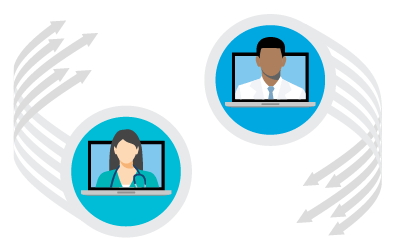Blog
HCP Engagement Strategies for Today’s Hybrid Commercial Model
Mar 06, 2023 | Andy Fuchs
Mar 06, 2023 | Andy Fuchs
The way that customers engage with pharma companies is changing dramatically. As digital transformation sweeps across the industry, new communication channels are opening up, allowing companies to reach and engage with customers in new ways. Engagement is increasingly becoming less of an outward push by companies to their customers and more of a two-way pull conversation that empowers healthcare professionals (HCPs) to get the information they need when they need it.
While this proliferation of new channels can present challenges, it also offers organizations a strategic road map for connecting with HCPs on their terms, guided by the deep insight into customer preferences that is now possible.
Understanding HCP preferences to better tailor engagement
A digital engagement strategy offers pharma companies a number of new ways to connect with HCPs. However, due to a wide variety of differing HCP preferences, it can be challenging for reps to know the best engagement strategy to use with each customer. What is the best channel to engage this HCP in? When is the best time to do so? And with what type of content? One of the key benefits of a digital strategy is that it can offer this kind of precise insight.
There is no one-size-fits-all approach for engaging with doctors, but personalization of communication is a top factor in doctor satisfaction with pharma. Commercial teams can start by leveraging the CRM data they already have on HCP preferences and behaviors, as much of it is being automatically recorded with each customer engagement.
Combining this data with additional data, such as patient, prescriber, and sales data, further improves segmentation and targeting. A streaming patient data platform can help to provide even more accurate data linkages with no downstream privacy risks, which can be a boon to companies selling modern, complex products.
Opening new channels of inbound communication

In addition to improvements in outbound communication, there are benefits to be seen from new pull engagement channels, too. For example, making it easier for HCPs to quickly find the people, information, and services they need—and exactly when they need it.
Such two-way engagement puts the focus squarely on the customer. When HCPs can connect quickly with experts, request samples, or find patient-facing materials instantly online, doctors can get the right treatments to their patients as efficiently and as quickly as possible.
Generally, a pull model better meets HCP needs because it gives them a convenient way to stay connected to reps and medical science liaisons (MSLs) in between meetings. This approach can also increase engagement with underserved or hard-to-reach HCPs, helping avoid missed opportunities and expanding access.
Aligning sales and marketing efforts
With digital engagement as important to field teams today as it is to marketing, visibility into all customer engagement tactics is necessary in order for companies to provide an optimal omnichannel experience—and this includes all personal (sales-led) as well as non-personal (marketing-led) tactics.
For example, a company can measure the impact of its marketing promotions on HCP prescribing behavior to gain deeper insight into how its marketing efforts are reinforcing field activities. It can then communicate with those HCPs who are less receptive to rep outreach.
Commercial teams can orchestrate strategies across sales and marketing using their CRM platform to trigger the next best step in the customer journey. Having a holistic view of every customer touchpoint enables companies to engage in the most effective way possible: at the best time, in the best channel, and with the best content.
Content considerations for digital excellence
Tailoring engagement based on customer preferences is just one pillar of an effective digital strategy. Having the right content is equally critical to developing your new approach. Here are three essential considerations:
- Relevance: There’s no mystery regarding the types of content HCPs require in this on-demand world. Ultimately, it comes down to providing relevant content that adds value. If you provide relevant content, you will increase your opportunities for engagement and may even see HCPs reach out for more.
- Speed: Digital engagement requires faster content creation and review. That’s why brands embrace new modular content strategies that help them quickly deliver and repurpose compliant, personalized content across markets, channels, and regions.
- Quality: Less is often more when it comes to engaging with HCPs. There’s value in focusing on quality content over quantity.
To learn more about accelerating the content lifecycle and maximizing field impact, download our new ebook, The Commercial Leader’s Guide to Digital Excellence.